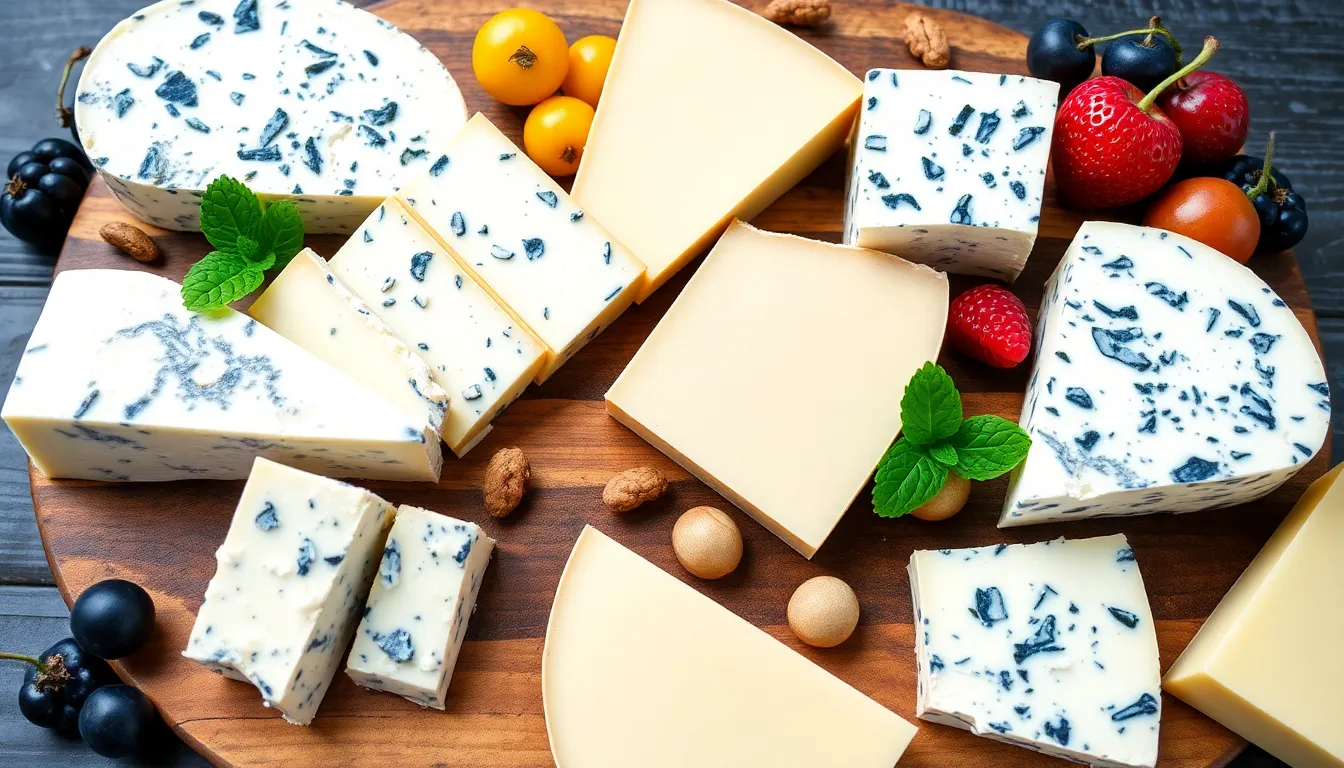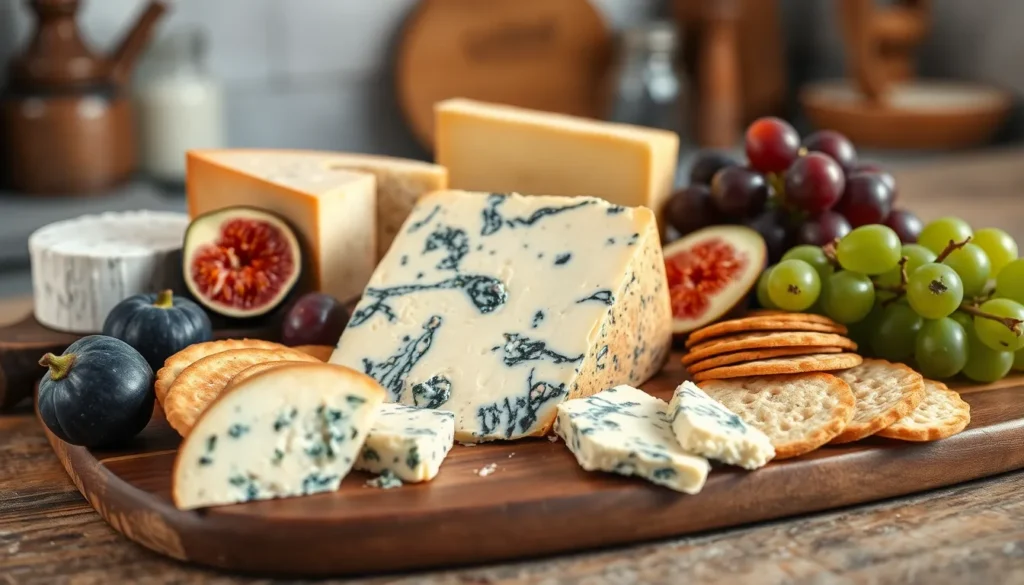Table of Contents
ToggleWhen it comes to cheese, few names spark as much debate as gorgonzola and blue cheese. Are they the same? Is one just a fancy Italian cousin of the other? Picture this: a cheese board filled with a variety of flavors, and right in the middle, the bold, tangy presence of gorgonzola, trying to steal the spotlight from its blue-veined counterparts.
Understanding Gorgonzola
Gorgonzola stands as a distinguished type of blue cheese originating from Italy. Its rich flavor profile and unique characteristics set it apart within the realm of blue cheeses.
Origin and History
Gorgonzola originates from the town of Gorgonzola, located near Milan, Italy. Historical records trace its production back to the 9th century, highlighting its long-standing heritage. Initially made from cow’s milk, this cheese evolved over centuries, gaining popularity throughout Italy and beyond. The use of cultures and molds produced a distinct taste, contributing to its reputation. By the late 19th century, Gorgonzola received its official designation as a protected cheese. This acknowledgment ensured quality standards and authenticity in production methods.
Types of Gorgonzola
Two primary types of Gorgonzola exist: Gorgonzola Dolce and Gorgonzola Piccante. Gorgonzola Dolce features a creamy texture with a milder, sweeter flavor, making it suitable for spreading. This variation typically matures for around three months. In contrast, Gorgonzola Piccante boasts a firmer texture and a more intense flavor profile due to longer aging, which ranges from three to six months. Both types showcase the versatility of Gorgonzola in culinary applications, from pasta dishes to cheese boards.
Exploring Blue Cheese

Blue cheese encompasses a range of cheeses characterized by their distinctive blue or green veins. These veins result from the mold Penicillium, which is intentionally introduced during production. Texture varies; cheeses can be creamy, crumbly, or firm. Flavors often range from mild to strong, with many offering a tangy or sharp taste that sets them apart.
What Defines Blue Cheese?
Several factors define blue cheese. Ingredients, primarily cow’s, goat’s, or sheep’s milk, play a crucial role in the final flavor. Production methods include inoculation with specific molds, aging in controlled environments, and monitoring humidity. These elements work together to develop unique characteristics, contributing to the overall taste and aroma. Many consumers appreciate blue cheese for its complex profiles and versatility in various dishes.
Popular Varieties of Blue Cheese
Numerous blue cheese varieties exist, each offering its distinct flavor and texture. Roquefort hails from France and features a strong flavor with a creamy texture. Stilton, a British classic, combines a crumbly texture with a rich and tangy taste. Maytag blue represents an American version, crafted in Iowa with a sharp flavor profile. Other notable types include Gorgonzola, established in Italy with its creamy and robust varieties, and Danish Blue, known for its mildness. Each variety adds a unique dimension to culinary creations, satisfying various palates.
Is Gorgonzola the Same as Blue Cheese?
Gorgonzola and blue cheese share common features but differ in unique ways. Both belong to the blue cheese category, recognized for the blue or green veins created by the mold Penicillium. Each type boasts bold flavors and pairs well with various culinary dishes, making them popular choices on cheese boards.
Similarities Between Gorgonzola and Blue Cheese
Gorgonzola and blue cheese both utilize Penicillium molds, which produce their distinctive marbling. These cheeses exhibit a range of flavors from mild to sharp, appealing to diverse palates. Chefs often integrate them into salads, dressings, and sauces, further showcasing their versatility in cooking. Texture also plays a role, as both types can be creamy or crumbly, depending on aging. Connoisseurs appreciate both for their unique contributions to charcuterie boards and gourmet dishes.
Key Differences
Gorgonzola stands out as an Italian blue cheese, while blue cheese encompasses several varieties from different regions. Gorgonzola Dolce offers a creamier, sweeter profile compared to the sharper notes of many blue cheeses. Aging processes also differ; Gorgonzola ages for a specific period, typically between three months and a year, leading to distinct flavors and textures. Additionally, the milk source varies; Gorgonzola primarily uses cow’s milk while other blue cheeses may incorporate sheep’s or goat’s milk. A protected designation ensures that authentic gorgonzola meets specific quality standards.
Culinary Uses of Gorgonzola and Blue Cheese
Gorgonzola and blue cheese offer diverse culinary applications, enhancing dishes with their unique flavors.
Recipes Featuring Gorgonzola
Gorgonzola shines in various recipes. It works well crumbled over salads, adding a creamy richness to mixed greens and fruits. Pasta dishes benefit from gorgonzola’s tangy notes, particularly in creamy sauces or risottos. Pizzas topped with gorgonzola, paired with pears or nuts, create an appealing flavor contrast. Additionally, it complements meats like steak and chicken, enhancing their savory profiles with its unique taste. Gorgonzola’s versatility makes it an excellent choice for gourmet cheeseboards, paired with honey, figs, or dried fruits.
Recipes Featuring Blue Cheese
Blue cheese features prominently in multiple culinary creations. Dressings for salads often incorporate blue cheese, lending a sharp and savory quality to the mix. Bacon-wrapped appetizers, with blue cheese stuffed inside, create a delightful combination of flavors. A classic meatball recipe might include blue cheese, enriching the dish with a bold kick. Cheese dips benefit from blue cheese, perfect for pairing with crackers or vegetables. Blue cheese also serves as a fine accompaniment to fruits, particularly pears and apples, balancing sweetness with its distinct sharpness.
Gorgonzola and blue cheese may share similarities but they each bring unique characteristics to the table. Gorgonzola’s rich history and distinct flavor profiles set it apart within the blue cheese category. Whether one prefers the creamy sweetness of Gorgonzola Dolce or the sharper notes of Gorgonzola Piccante, both types offer versatility in culinary applications.
Understanding these differences enhances the appreciation for both gorgonzola and blue cheese. As cheese lovers explore various dishes and pairings, recognizing the nuances can elevate their culinary experiences. Ultimately, gorgonzola stands as a proud representative of Italian cheese craftsmanship while still embracing its blue cheese roots.







